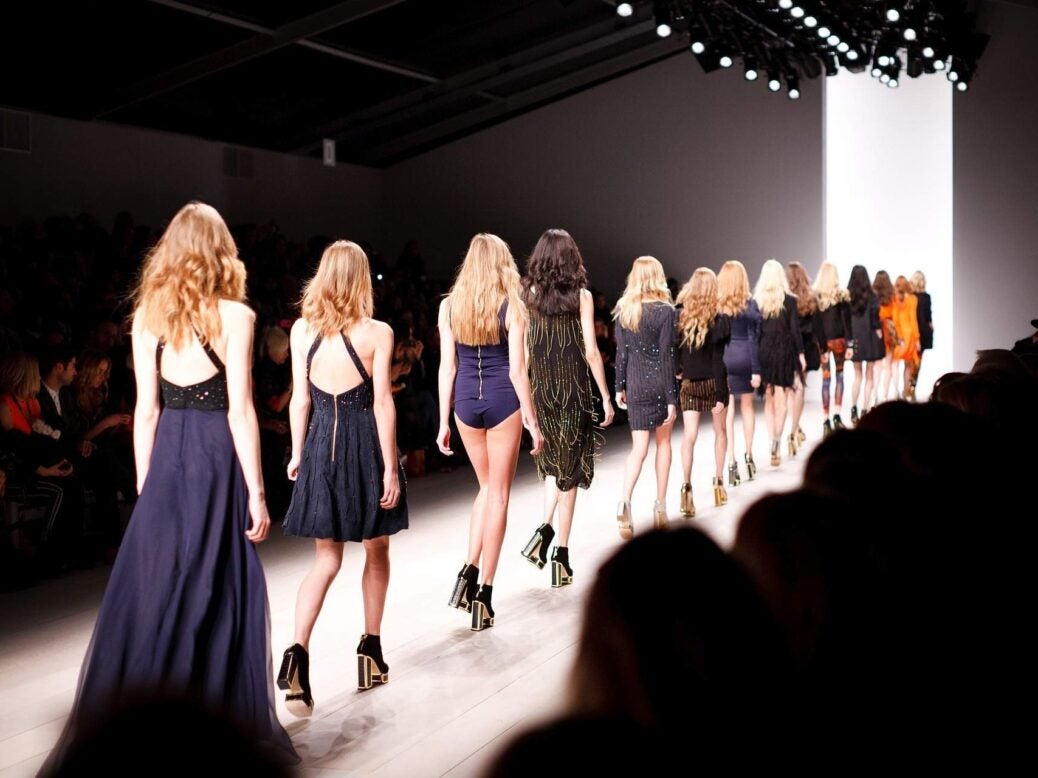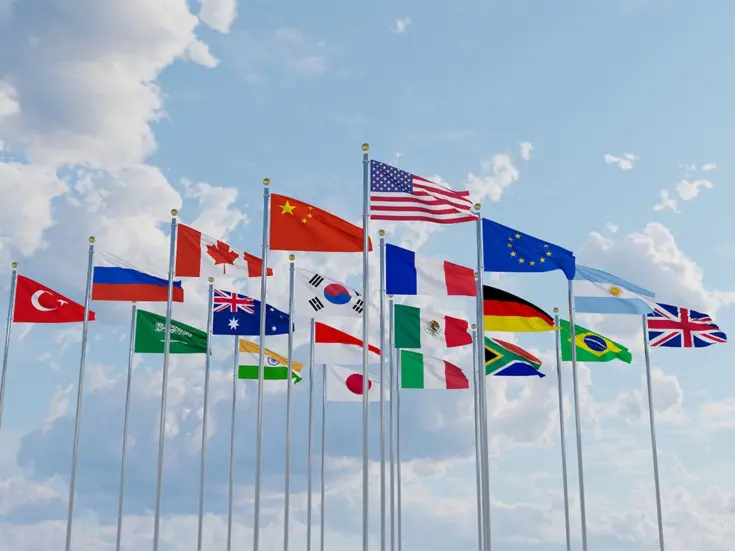
The likes of Kering, Richemont and LVMH built empires on non-stop schedules of runway shows, globe-trotting and new collections. Without after-parties or air-kissing, how will they evolve?
Covid-19 was the perfect storm for all kinds of retail business. As nations locked down and the global economy contracted, housebound and cash-poor consumers had neither the opportunity nor the desire to shop. The luxury sector was hit particularly hard as consumers de-prioritised discretionary spending. Online sales of high-end fashion and associated goods declined by 5-20 per cent across Europe, 30-40 per cent in the US and 15-25 per cent in China, according to a report from the Business of Fashion (BOF).
The average market capitalisation for firms in the industry dropped almost 40 per cent between the start of January and March, according to Boston Consulting Group (BCG) – a significantly steeper decline than that of overall market indices.
What’s more, the consultancy says, global sales for luxury goods could end up 30-40 per cent lower in 2020 than 2019. That’s a drop in sales of up to $625 billion worldwide.
In the face of such decline, businesses have focused on liquidity by introducing dedicated cash-management programmes. ‘Brands took initiatives including creating commercial SWAT teams to be able to drive fast decisions and prepare for a large amount of excess inventory,’ says Sarah Willersdorf, global head of luxury at BCG.
‘When it all kicked off, you had the spring/summer seasons already in store,’ says Helen Brocklebank, CEO of Walpole, a trade body representing 270 UK luxury brands. ‘So every retailer was wondering how on earth they were going to sell a whole season when nobody can shop and nobody’s got anywhere to go.’
Some turned to discounting, with items being marked down for longer than in traditional seasonal reductions. Others pivoted to meet demand, repurposing factories to manufacture face masks. But cutting costs and churning out PPE alone wasn’t going to save the 56 per cent of global fashion companies that were not earning their cost of capital in 2018. In many quarters, the consensus is that the crisis uncovered a need for fundamental and systemic change.
As the BOF State of Fashion Report 2020 put it: ‘Fashion is currently focused on crisis management and contingency planning, but eventually we must shift towards re-imagining our industry altogether.’
The question of whether luxury’s tried and tested approach to showing and delivering collections is appropriate in a sustainable, globalised and digitised world is one that has long been simmering.
‘Is constant newness the right thing to do in a world where we should be consuming less?’ Brocklebank muses. ‘“Buy less, buy better” was something that Walpole was already talking about, but it took on emergency proportions during the pandemic.’ In addition to thinking about sustainability, waste and the excess engendered by an endless cycle of fashion shows and seasonal collections, the industry has also placed fresh emphasis on digital opportunities.
According to Brocklebank, prevailing wisdom in the industry is that ‘25 per cent of luxury transactions will be online by 2025’, but she now expects that figure to be reached by 2022. It is not just shopping that is going online – so are fashion shows and buying meetings.
Since the start of the pandemic it has become apparent that the extravagant world of fashion and luxury can be run from a computer, at a fraction of the price and carbon footprint. For an industry that produces about 1.2 billion tonnes of carbon per year, this is no small revelation.
‘There was an overconsumption conversation going on,’ says Brocklebank. ‘You would fly models around the world to do a show, and then fly back to Milan, and then to Paris. Samples are going back and forth between factories and head offices. Now you can’t have that, you have to think differently.’
Megabrand Gucci acted on this realisation promptly, announcing that not only would its shows be going digital, but they would also be reduced in number, from eight per year to two. ‘We went way too far,’ wrote creative director Alessandro Michele in an Instagram post. ‘This crisis has exemplified such transformative urgency, which can’t be deferred anymore… That is why I decided to build a new path, away from deadlines that the industry consolidated and away from an excessive performativity that today really has no raison d’être.’
In the same Instagram post, Michele also announced his plans to go ‘seasonless’, eschewing a fashion calendar that has no correlation to actual weather patterns and perennially thwarts customers’ desire to ‘buy now, wear now’.
‘Even before the crisis,’ says Willersdorf, ‘the fashion and luxury industries were working to reconcile the disconnect between the long-entrenched cycles for unveiling, delivering and marking down merchandise, and the reality of consumers’ shopping habits. The crisis has intensified the need for change in order to reduce expenses, increase margins and operate more sustainably.’
Recycling – a foreign concept to fashionistas of yesteryear – is also being pushed into the mainstream. This is a marked change of tack for an industry where, until recently, companies would incinerate unsold inventory rather than risk deprecating the value of their brand by selling it cheaply, or giving it away. ‘There is an admission that the circular economy is real, and luxury players are engaging more with the second-hand market,’ says Kelly Miely, retail consulting partner at Deloitte.
***
Between the uptick in digital shopping and shows, the reduction of waste and growing acceptance of repurposing, US Vogue editor Anna Wintour has described the pandemic as ‘an opportunity for all of us to really think about the amount of money, the consumption and the excess that we have all indulged in’.
However, not everyone is as welcoming of this new way of doing things. This has led the sector to split into two camps.
Milan Fashion Week, which coincided with the realisation that coronavirus was spreading in Italy (possibly thanks, in part, to the movements of Chinese workers returning to Italian garment factories from New Year celebrations), foreshadowed the way brands would respond to Covid-19. Even as uneasy attendees recoiled from air-kisses, Dolce & Gabbana proceeded with its show.
Meanwhile, Giorgio Armani took the decision to uninvite guests ‘to safeguard [their] wellbeing’ and live-streamed its autumn/winter 2020 collection. Since then, Saint Laurent, which is also part of luxury conglomerate Kering, has followed Gucci’s lead. The company issued a statement to explain that it was ‘conscious of the current circumstance and its waves of radical change’ and had ‘decided to take control of its pace and reshape its schedule’.
Designer Dries Van Noten rallied industry figures to sign an open letter calling for change. Tory Burch, Chloé, Erdem, Marine Serre and Grace Wales Bonner have all committed to reducing the amount of clothing produced, as well as to selling collections in a way that mirrors the seasons of nature more closely.
The British Fashion Council and the Council of Fashion Designers of America also joined the movement, releasing a joint statement: ‘There is a clear disconnect from when things arrive in store to when the customer actually needs them… we strongly recommend designers focus on no more than two main collections a year.’
Other brands are less enthusiastic. Bruno Pavlovsky, president of fashion at Chanel, told BOF he feels ‘it’s important’ that Chanel do six shows per year. ‘The pace is to be able to deliver novelty at the boutique level every two months, and we feel very comfortable with that pace,’ he said, adding that he hoped fashion’s culture of continent-hopping would return.
LVMH brand Dior has also been reluctant to tear up the calendar. Chief executive Pietro Beccari has said that ‘there will always be a place in fashion for a live fashion show’ and announced that the house ‘will follow the rhythm of fashion week’. Robert Senior, founding partner at luxury-focused venture capital firm Redrice Ventures, identifies a level of ‘complacency’ in such a mindset and is critical of brands that are content to ‘replicate the past to try and reclaim some sort of normality’.
‘I’m really excited by the ones that are creating the new norms,’ he says. ‘This is not a retrospective. You have to be thinking, “What might in the future look like?”’
But why wouldn’t you embrace this once-in-a-lifetime opportunity to create a ‘new normal’? Perhaps brands are eager to cling to the aspirational, magical quality of the fashion world.
A second consideration is that barriers to entry have been erected. Powerful brands can stage the biggest shows in the most far-flung locations with the most lavish afterparties. Dispensing with these things might create opportunities for upstarts and leave the incumbents with an identity crisis. How could they differentiate themselves? This fear is not without foundation.
The pandemic has gone some way to levelling the playing field for smaller brands, which can reach consumers much more cheaply if there is no expectation of physical stores or extravagant events. ‘The cost of putting on a fashion show was very, very high, but now we’re seeing people doing digital runways and live streaming shows,’ says Miely. ‘As you move down the tiers, that’s where there is a real impetus to change.’
Smaller brands can also be more flexible. ‘This is a time where small is surely beautiful, just because of sheer agility,’ says Senior. ‘If you don’t have the prison of overheads you can do whatever you want on a sixpence. The start-ups are going, “Brilliant, let’s go,” whereas the legacy companies, I think they’re having a tough time right now.’
The larger and sometimes slower-moving luxury houses may have to place renewed focus on the most essential element of their businesses: creativity. Indeed, some major players have begun to take innovative approaches to bringing products to their audience.
Hermès recently commissioned edgy graphic designer Pablo Rochat to create short videos in which he used Photoshop to turn an orange, a violin and a traffic cone into the brand’s signature orange box as part of an Instagram marketing campaign. In October, Rihanna teamed up with Amazon to stage a show to launch a collection from her Fenty label. It was available to stream via Amazon Prime Video, offering audiences the chance to ‘shop the collection’, blurring the line between entertainment and retail.
Burberry’s London Fashion Week show was a ‘phygital’ spectacle, where models catwalked in an ethereal woodland setting. ‘It was the most exciting Burberry show we’ve ever seen,’ says Brocklebank. ‘It was an art moment, rather than a fashion show. You couldn’t do that in real life. There’s been a real renaissance of creativity.’
Winners in the long term are likely to be those that find new ways to engage with shoppers, rather than wait for a resurgence of bricks and mortar retail that might never come. E-platforms, of course, will be front and centre. The idea that technology-driven, digital experiences are not as good as going to a show or a shop, but are merely ‘better than nothing’, is ‘being flipped’, says Senior.
In addition to consumer-facing marketing campaigns and retail experiences, the technology on the inside of luxury businesses is expected to be crucial. A Deloitte survey of the sector revealed that 57 per cent of respondents planned to invest in innovation such as AI and big data analytics.
‘Ultimately the adoption of an enterprise-wide technology backbone will become a key differentiator,’ says BCG’s Sarah Willersdorf. ‘The benefits include improved in-season inventory management and markdowns, and it can help brands customise their value proposition to a hyper-personalised level.’
***
This notion of ‘personalisation’ will be key in ‘going beyond products and driving consumer engagement’, adds Willersdorf, with many brands testing things such as virtual shopping appointments and ‘virtual tryon’.
Brocklebank is excited about innovations in ‘clienteling’, the practice of establishing relationships with customers based on their behaviours and purchases. ‘The one challenge with digital is it’s not always a very luxury experience,’ she says. ‘But you’ve got really interesting things happening with personal shopping online.’
Farfetch is one brand exploring this channel, partnering with the Shopper by Fashion Concierge app to source hard-to-find pieces for private clients. In China, meanwhile, Burberry is investing in ‘social retail’. The British brand has partnered with tech giant Tencent to launch a luxury concept store that uses social media interactions; a WeChat programme allows shoppers to unlock exclusive content and personalised experiences that they can share on social media.
‘You’re transacting and also chatting and experiencing the world all through one platform,’ Brocklebank explains. ‘That’s genuine innovation.’ Another area where many brands will focus significant efforts in the post-Covid economy is ‘brand purpose’.
‘There is a physics and a chemistry to this,’ says Senior. ‘The physics is: “Where do I shop? How do I shop?” The chemistry is: “How do I feel about who I’m buying from?” At the moment when we look at early-stage businesses, yes, we look at the business plan, but we also ask, “Why are they doing it? What is their attitude to social issues?”
Covid-19 has accelerated this sort of mindfulness. Increasingly the values of a brand will determine the brand’s value.’ Indeed, the fallout from the revelations over Boohoo’s Leicester factory, where the retailer was accused of paying its garment workers just £3.50 an hour and operating without additional hygiene or social distancing measures, shows what is at stake for businesses that fail to embrace the new, low-contact, low-carbon, humanitarian way of life.
In an industry that has always fixated on the ‘new new thing’, being stuck in the past is going out of style.
Read more
The Spear’s Luxury Index 2020: Elle B. Mambetov
We need to Make the West End Great Again










